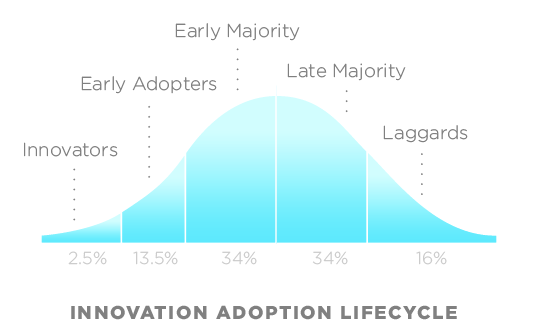📊 Business Context
What is it about?
- The Early Adopter (EA) segmentation classifies customers according to their likelihood to buy new products.
- The more new products the customer buys, the higher the EA segment is (4 segments in total: EA --, EA -, EA +, EA ++).
- Segmentation restricted to customers with at least 3 purchases (others are not segmented)
- A customer is considered an early adopter if he purchases a product within 90 days after its first sale.
Why focus your efforts on early adopters?
- The term early adopter refers to “Diffusion of Innovations” (1962), a book in which Everett M Rogers the communication scholar and sociologist, describes 5 types of adopters for products and provides insight into each of those types.
The graph below highlights these 5 types.
- Early adopters attributes:
- They will often have a degree of “thought leadership” for other potential adopters.
- They may be very active in social media and often create reviews and other materials around new products that they strongly like or dislike.
- They will try to obtain more information than an innovator in this decision-making process.
What are the main use cases?
- Push new products to EAs first :
- Through any channel: Email & web personalization, loyalty programs, dedicated events to try new products.
- Encourage review generation from these clients:
- Gift or discount after review.
- Questionnaire after purchase.
- Free samples.
- Facilitate access to information needed by EA: ROPO use cases.
What business impact can I expect?
- Impact on: Retention, New sales.
- Level of impact: ⭐️⭐️️⭐️️⭐️
↔️ Inputs & Outputs
Data input
A dataset made of Orders with at least the following attributes :
order_id: unique identifier of the transaction.
customer_id: unique identifier of the customer who made the purchase.
order_date: date at which the purchase was made.
order_details: list of product ids within a purchase.
A Customers dataset with the following attributes
customer_id: unique identifier of the customer who made the purchase.
- A dataset containing your Products data, with columns for:
product_id: unique identifier of each product.category_id: unique identifier of each product.
User Settings
Users can adjust the following settings according to their needs :
- The number of new products to purchase to get to each segment (EA --, EA -, EA +, EA ++).
- Segment restriction:
- Default segmentation is restricted to customers with at least 3 purchases (others are not segmented).
- The default period for a product to be considered new is 90 days (from its first sale).
Expected output
- The output of this recipe is a new Dataset with 3 output columns :
first_purchase_date: first purchase date per product.new_product_purchased_count: part of new products purchased per customer.early_adopter_score: decile of customer sensitivity to new products (from 1 to 10).
- You can then make a join between your new Early Adopters Dataset and your existing Contacts Dataset to map your
early_adopter_scorefor instance.
🖥️ Implementation in Octolis
1. Prepare your input data
Make sure that you have built an Dataset containing all your orders.
In case you have several order Sources (e.g. eShop & PoS) you need to group all sources into an orders master Dataset.
2. Apply the SQL Template “Early adopter Segmentation”
- Create a new Dataset using SQL expert mode.
- Copy / paste the following SQL template.
- After pasting the template, make sure to modify all variables with the names of your input columns.
- Add your Early adopter Segmentation Dataset as a source of your Contacts Dataset, and map the needed fields to import them into your Contacts Dataset.
sql// Early adopter Segmentation SQL Template

